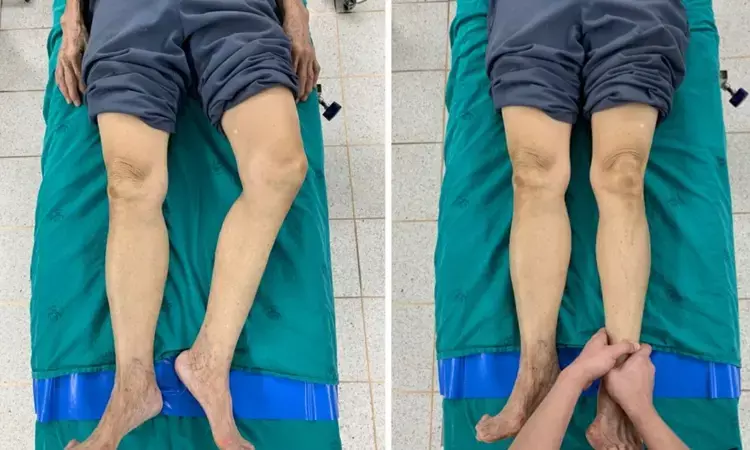- Home
- Medical news & Guidelines
- Anesthesiology
- Cardiology and CTVS
- Critical Care
- Dentistry
- Dermatology
- Diabetes and Endocrinology
- ENT
- Gastroenterology
- Medicine
- Nephrology
- Neurology
- Obstretics-Gynaecology
- Oncology
- Ophthalmology
- Orthopaedics
- Pediatrics-Neonatology
- Psychiatry
- Pulmonology
- Radiology
- Surgery
- Urology
- Laboratory Medicine
- Diet
- Nursing
- Paramedical
- Physiotherapy
- Health news
- Fact Check
- Bone Health Fact Check
- Brain Health Fact Check
- Cancer Related Fact Check
- Child Care Fact Check
- Dental and oral health fact check
- Diabetes and metabolic health fact check
- Diet and Nutrition Fact Check
- Eye and ENT Care Fact Check
- Fitness fact check
- Gut health fact check
- Heart health fact check
- Kidney health fact check
- Medical education fact check
- Men's health fact check
- Respiratory fact check
- Skin and hair care fact check
- Vaccine and Immunization fact check
- Women's health fact check
- AYUSH
- State News
- Andaman and Nicobar Islands
- Andhra Pradesh
- Arunachal Pradesh
- Assam
- Bihar
- Chandigarh
- Chattisgarh
- Dadra and Nagar Haveli
- Daman and Diu
- Delhi
- Goa
- Gujarat
- Haryana
- Himachal Pradesh
- Jammu & Kashmir
- Jharkhand
- Karnataka
- Kerala
- Ladakh
- Lakshadweep
- Madhya Pradesh
- Maharashtra
- Manipur
- Meghalaya
- Mizoram
- Nagaland
- Odisha
- Puducherry
- Punjab
- Rajasthan
- Sikkim
- Tamil Nadu
- Telangana
- Tripura
- Uttar Pradesh
- Uttrakhand
- West Bengal
- Medical Education
- Industry
Traction-Internal Rotation Radiograph Can Improve Agreement in AO/OTA Classification System for Intertrochanteric Fracture

The AO/OTA classification is widely accepted for intertrochanteric fractures regarding its higher reliability compared to other systems and may lead to appropriate treatment options.
A study by Chittawee Jiamton et al has shown moderate to substantial for both inter-observer and intra-observer agreement. Adding traction-internal rotation to the standard radiograph can improve the agreement and may be helpful in the surgical decision and implant options.
The standard anteroposterior radiograph of both hips was obtained in the patient positioning supine in resting position; the beam is perpendicular to the center, pubic symphysis, and 1 m in distance from cassette. Then the traction internal rotation was performed by a well-trained-orthopedic resident, manually gently applying the longitudinal traction force by holding the ankle until the affected leg length was approximately equal to the normal side and internally rotating approximately 15 degree or patella facing upward to accommodate femoral anteversion. After the radiographic was done, the force is gently released to avoid any sudden movement to minimize the pain of the patients. Patients who were in excruciating discomfort were given intravenous analgesics prior to having radiographs taken.
In 100 cases, three sets of radiographs of intertrochanteric fracture were prepared. Two senior and two junior orthopedic trauma surgeons were asked to classify the radiograph according to AO/OTA classification. The standard both hips radiograph, traction-internal rotation radiograph and combination of both techniques were evaluated. All radiographs were evaluated at two different points in time for all observers. The inter- and intra-observer reliability were analyzed with the Kappa agreement index.
Key findings
• Inter-observer agreement for standard radiographs was "substantial" in one while "moderate" in five among observers. After adding the traction radiograph to the standard radiograph, the agreement was improved to "substantial" in 4 while the rest was "moderate."
• Intra-observer agreement for standard radiographs was "substantial" in two observers and "moderate" in two observers. Adding traction to standard radiographs resulted in "substantial" in three observers and "moderate" in one observer.
• Overall pattern stability was changed in 19% after adding the traction film.
• Thirty-four percent of the fracture which initially diagnosed as A2.1 was changed from stable to unstable fracture patterns after adding the traction film.
The authors concluded that - "Adding traction-internal rotation radiograph to the standard anteroposterior radiograph of both hips is a useful method for improving agreement to classify intertrochanteric fracture regarding AO/OTA classification. We suggest performing traction film in the patient classified as A2 in the standard view due to the relatively high chance of changing the classification. This may be helpful in fracture classification which possibly effects the treatment options."
Further reading:
Traction Internal Rotation Radiograph Can Improve Agreement in AO/ OTA Classification System for Intertrochanteric Fracture
Chittawee Jiamton, Prapinporn Sayan et al
Indian Journal of Orthopaedics (2022) 56:1998–2005
https://doi.org/10.1007/s43465-022-00722-4
MBBS, Dip. Ortho, DNB ortho, MNAMS
Dr Supreeth D R (MBBS, Dip. Ortho, DNB ortho, MNAMS) is a practicing orthopedician with interest in medical research and publishing articles. He completed MBBS from mysore medical college, dip ortho from Trivandrum medical college and sec. DNB from Manipal Hospital, Bengaluru. He has expirence of 7years in the field of orthopedics. He has presented scientific papers & posters in various state, national and international conferences. His interest in writing articles lead the way to join medical dialogues. He can be contacted at editorial@medicaldialogues.in.
Dr Kamal Kant Kohli-MBBS, DTCD- a chest specialist with more than 30 years of practice and a flair for writing clinical articles, Dr Kamal Kant Kohli joined Medical Dialogues as a Chief Editor of Medical News. Besides writing articles, as an editor, he proofreads and verifies all the medical content published on Medical Dialogues including those coming from journals, studies,medical conferences,guidelines etc. Email: drkohli@medicaldialogues.in. Contact no. 011-43720751


